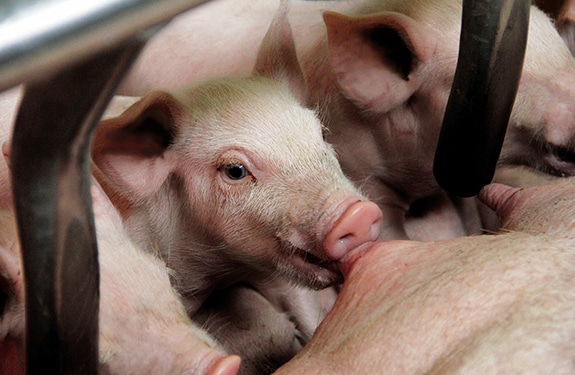08 Apr Yeast probiotic solution in hyper prolific sows to improve weaning piglet weight & reduce mortality in lactation
Géraldine Kuhn (Europe & CIS Swine Manager – Phileo by Lesaffre), Maria Oficialdegui (Director Técnico – Los Alecos, Barasoain (España) & Angel del Río (V&S Asociados) with the collaboration of Iñigo Berrogui and his team Farm manager (Los Alecos)

Players in the swine industry are currently looking for new ecological, functional and cost-effective alternatives to meet the growing demand for products of high sanitary and nutritional quality. In the context of increasing bacterial resistance, measures to promote responsible use of antibiotics in farms become compulsory.
From lactation to weaning: an obstacle course for piglets
Use of hyperprolific sow lines is producing smaller weaners and therefore more fragile piglets:
- Litter weight at weaning can drastically be reduced
- A lack of immunity can induce an increase of suckling mortality
- The surviving piglets may have stunted
Stresses piglets face cause physiological changes that can have considerable economic consequences (Campell et al., 2013, Heo et al., 2013):
- Digestive disorders of varying intensity and duration
- Reduced feed intake for 2 to 3 days (Brooks et al., 2001, Bruinininx et al., 2002)
- Changes of gut mucosa (Marion et al., 2002) slower gut motility and gastric laziness (Lallès et al., 2004)
Taking care of piglets at early stage is becoming fundamental: enhancing immune system by quality colostrum, encouraging feed consumption as quickly and effectively as possible and supporting health of the piglets by taking good care of the sows are clearly essential.
Among possible strategies, probiotics are used to promote the health and performance of animals (Kenny et al. 2011, Cheng et al. 2014) and probiotic yeasts have been widely used to improve intestinal health.
Indeed, publications showed the positive effect of the yeast probiotic Saccharomyces cerevisiae on the health and performance of sows (Jang et al., 2013; Jurgen et al., 1997; Zanello et al., 2011) mainly linked to the modulation of microbiota as well as by improving immunity of piglets linked to a better quality of colostrum and milk (Lizardo et al., 2008, Trockova et al., 2014, Posadas et al., 2017, Zanello et al., 2013, Trevisi et al., 2015) and by reducing inflammation after an E.coli challenge.
To validate the efficacy and benefits of supplementing the diets of gestating and lactating sows with yeast probiotic Actisaf® Sc47 (Phileo by Lesaffre, France) in the field, a study was carried out on a Spanish commercial farm looking at sows and suckling piglets’s zootechnical performance.
Maternal feeding to optimize the full genetic potential
A Spanish commercial farm (1700 sows – 82 sows weekly, using Danbred genetic sow line and Topigs Duroc for the boar line) having zootechnical performance close to 36,7 weaned per sow per year, decided to set up a trial to try solving high challenges experienced in suckling period, especially the control of the mortality and the possible low weight at weaning. Two batches were followed.
 The sows were separated in two groups (Control vs Actisaf®). To avoid parity effect, each group was composed of the same number of sows of similar parity (cycles from 2 to 6). The groups (40 sows in average – Table 1) received a gestating and lactating sow’s diet currently used in the farm. In addition, only sows involved in the Actisaf® group received the equivalent of 1kg/T of Actisaf® in a complete feed for the last 4 weeks of gestation and during whole lactation (Table 1).
The sows were separated in two groups (Control vs Actisaf®). To avoid parity effect, each group was composed of the same number of sows of similar parity (cycles from 2 to 6). The groups (40 sows in average – Table 1) received a gestating and lactating sow’s diet currently used in the farm. In addition, only sows involved in the Actisaf® group received the equivalent of 1kg/T of Actisaf® in a complete feed for the last 4 weeks of gestation and during whole lactation (Table 1).
To follow the usual program provided by the farm, all the litters were supplemented with milkreplacer containing another bacterial-based probiotic during the whole lactation period. The cross-fostering – equalling to 16 piglets per sow – was done after the colostrum intake and within the respective groups.
During the study, the following data were registered for statistical analysis:
- Litter weight at birth and at weaning, mortality during suckling period
- Diarrhoea score
- Number of weaned piglets were recorded by the manager of the farm
Better start… Better performance at weaning!
Zootechnical performance at birth
Although yeast probiotic was added only the last 4 weeks of gestation, the prolificacy of the Actisaf® group was significantly better than the Control group (17.9 vs. 16.3, P=0.016 – respectively) while we did not expect an improvement in this parameter by applying Actisaf® only the last 4 weeks. As a consequence, a positive trend was observed for the litter weight at birth in Actisaf® group (20.8 vs 21.8, P=0.242) (Figures 1 and 2).

Having more piglets at birth is important, it is even more crucial to keep them alive and healthy until weaning!
Analysis of the data obtained at weaning revealed a lower mortality (-13.6%) in the Actisaf® group, even if no difference was recorded in the diarrhoea score during the suckling period (Figure 3).

Mortality during first 21 days of lactation after cross fostering at birth
The number of piglets after 21 days of suckling was higher by 0.35 piglets in Actisaf® group compared to Control group (14.45 vs 14.10 respectively – Figure 3a). Litter weight was also significantly increased from 64.2kg in Control group to 70.0kg in Actisaf® group (P=0.037). This result allows to get an increased growth of the Actisaf® group by + 4.8kg piglets raised (Figure 5).

After 21 days of lactation, we observed that the piglets coming from the Actisaf® group are 245 g heavier compared to the Control group (Fig 6), showing that the supplementation of the sows supports the production of colostrum and milk of good nutritional quality.








Sorry, the comment form is closed at this time.